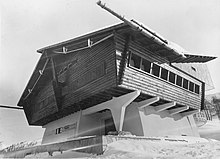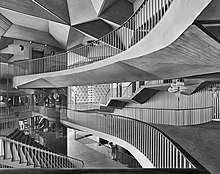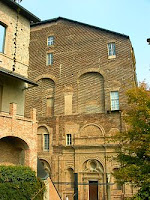NEW - Carlo Mollino - architect and polymath
A Renaissance man of the mid-20th century
The multi-talented architect Carlo Mollino, who designed buildings, interiors and furniture but whose talents also ran to writing and photography, racing car design, aerobatic flying and downhill skiing, was born on this day in 1905 in Turin. Mollino, whose style has been described as an eclectic fusion of the modern and the surreal, was responsible for several notable public buildings, including the Turin Chamber of Commerce and the headquarters of the Horse Riding Club of Turin, as well as several striking private residences and apartment buildings. He also designed the extraordinary Lago Nero Sled Station, at Sauze d'Oulx, the winter resort 50km (31 miles) north of Turin, and rebuilt the interior of the Teatro Regio opera house in Turin 40 years after a catastrophic fire left little behind the the 18th century facade intact. Never married in his 68 years, Mollino also had a deeply secretive side, which manifested itself in a number of apartments he kept, the whereabouts of which he disclosed to no one, not even his closest friends and acquaintances. One of these, in a 19th century villa overlooking the Po river in the centre of Turin, is now a museum, the Casa Mollino. Read more…
_____________________________________
Alessandra Ferri – ballerina
Dancing star who believes age is a matter of attitude
Prima ballerina assoluta Alessandra Ferri, who retired in 2007 but then made a triumphant return to ballet in 2013, was born on this day in 1963 in Milan. She marked her 55th birthday in 2018 by dancing at the Metropolitan Opera House in New York, at the Bolshoi Theatre in Moscow and the Hamburg Staatsoper, before performing at the Ravello Festival in Italy in July and in Tokyo in August. In a newspaper interview, Ferri said she was happy to be breaking barriers as an older woman in a youth-dominated world. She said she still has full confidence in her abilities and believes ageing is largely an attitude and her advice to other women of her age is ‘to keep moving’. Ferri began studying ballet at La Scala Theatre Ballet School. She moved to the upper school of the Royal Ballet School in London, where she won a scholarship that enabled her to continue studying there. She joined the Royal Ballet in 1980 and won the Laurence Olivier Award for her first major role in 1982. She was promoted to the rank of principal dancer in 1983. Ferri became principal dancer with the American Ballet Theatre under the direction of Mikhail Baryshnikow in 1985. Read more…
___________________________________
Rudolph Valentino - star of silent films
Heart-throb actor who died tragically young
The man who would become Rudolph Valentino was born on this day in 1895 in Castellaneta, a small town in a rocky region of Puglia notable for steep ravines. Born the second youngest of four children by the French wife of an Italian veterinary surgeon, he was christened Rodolfo Alfonso Raffaello Pierre Filibert Guglielmi di Valentina d'Antonguolla. When he arrived in America as an immigrant in 1913, he was registered as Rodolfo Guglielmi. His first movie credit listed him as Rudolpho di Valentina and he appeared under nine different variations of that name before achieving fame as Rudolph Valentino in The Four Horsemen of the Apocalypse in 1920. During the silent movie boom, he enjoyed more success in The Sheik, Blood and Sand, The Eagle and The Son of the Sheik and his smouldering good looks made him a 1920s sex symbol, nicknamed "The Latin Lover" and adored by countless female fans. Yet his route to fame was difficult. Unable to find work at home, he joined the exodus of southern Italians to the United States and aged just 18 boarded a boat to New York, disembarking at Ellis Island on 13 December, 1913. Read more…
____________________________________
The 1527 Sack of Rome
Mutinous army of Holy Roman Empire laid waste to city
An army loyal to the Holy Roman Emperor, Charles V, laid siege to the city of Rome on this day in 1527, at the start of the Sack of Rome, a significant event in the conflict between Charles and the so-called League of Cognac that had profound implications for Rome’s wealth and power. Rome at the time was part of the Papal States, who at the behest of Pope Clement VII had joined the League of Cognac – an alliance that included France, Milan, Florence and Venice – in an effort to stop the advance of the Empire, which had its centre of power in the Kingdom of Germany, into the Italian peninsula. After the Imperial Army had defeated the French at Pavia in the Italian War of 1521-26, it would have been a logical step for Charles to march on Rome but the attack is said to have come about not through any planned strategy but after a mutiny among his troops, many of whom were hired mercenaries, after it became clear there were insufficient funds available to pay them. Aware of the rich treasures they could seize if they stormed Rome and overthrew Clement VII, 34,000 Imperial troops, an army made up of Germans, Spaniards and Italians, demanded that their commander, Charles III, Duke of Bourbon, led them towards Rome. Read more…


.jpg)

.jpg)









.png)



.jpg)